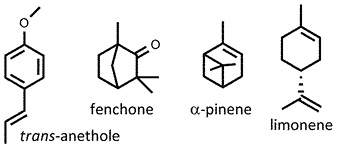 Foeniculum vulgare
Foeniculum vulgare
fennel
Back to “Salad herbs and herb mixtures: fennel (Foeniculum vulgare)”
Back to “Culinary herbs: fennel (Foeniculum vulgare)*”
Back to “Spices: fennel (Foeniculum vulgare)fr”
Foeniculum vulgare Mill. (Apiaceae); vinkel (Afrikaans); hui xiang (Chinese); fenouil (French); Fenchel (German); sanuf, saunf (Hindi); finocchio (Italian); fenneru (Japanese); funcho (Portuguese); hinojo (Spanish); phak chi (Thai)
DESCRIPTION All parts of the plant are edible – the compound leaves with their slender segments, the leaf stalks, white swollen stem bases and the small, dry fruits. They are greenish or yellowish brown, about 10 mm (⅜ in.) long, with five ribs on each of the two fruit halves (mericarps). A single resin canal is situated under each furrow. The flavour is similar to that of anise and liquorice, with a spicy, fresh aroma and a sweet anise-like taste. Fennel is sometimes wrongly called anise in the United States.
THE PLANT A perennial herb (up to 1.5 m or 5 ft) with compound, feathery leaves and small yellow flowers arranged in umbels. Sweet fennel, var. dulce, is commonly grown as a culinary herb and spice. The foliage is usually bright green but the decorative bronze fennel has purplish brown leaves. Florence fennel or finocchio, var. azoricum, is a smaller plant with white bulbous leaf bases that are eaten as a vegetable.1
ORIGIN Asia1 and the Mediterranean region (now global, and often an invasive weed). It was well known to the ancient Greeks, Egyptians and Romans.
CULTIVATION Fennel is frost-hardy, versatile and easily grown from seeds sown in spring. It does best in full sun and deep, well-drained soil.
HARVESTING The fruits are harvested by hand or mechanically just before they ripen. They are used as a spice or may be steam-distilled to obtain fennel oil.
CULINARY USES Fennel fruits are a commercial spice that is widely used in cooking and baking by almost all culinary traditions of the world. They are an important ingredient of curry powders, spice mixtures, pickles, herbal teas, soups, chicken dishes, fish, seafood, processed meats, sausages and breads. Whole or powdered fruits are used in tomato dishes, pastas, borsch and sauerkraut, as well as vegetables (cabbage, celery, cucumbers, onions and potatoes).2 The leaves are commonly added to fish and seafood dishes, both as garnish and for flavour (in the same way as dill). They give a fresh, herbaceous, aromatic, anise-like flavour to soups, stews and meat dishes. Florence fennel, raw and sliced, adds flavour to salads and to a variety of cooked vegetable and meat dishes. Powdered fruits or the anise-flavoured essential oil is widely used in beverages, teas, baked goods, ice creams, liqueurs and seasonings for meat products (e.g. pepperoni and other types of sausages).2
FLAVOUR COMPOUNDS The main aroma impact compounds in fennel fruits are trans-anethole and fenchone.3 Two types of fennel oil are distinguished:4 bitter fennel oil has 30 to 75% anethole, 12 to 33% fenchone and the level of α-pinene exceeds that of limonene; sweet fennel oil has 80 to 90% anethole, 1 to 10% fenchone and has more limonene than α-pinene. Anethole is also the main compound in anise (Pimpinella anisum).

NOTES Fennel is traditionally used in carminative and digestive medicines.
1. Mabberley, D.J. 2008. Mabberley’s plant-book (3rd ed.). Cambridge University Press, Cambridge.
2. Farrel, K.T. 1999. Spices, condiments and seasonings. Aspen Publishers, Gaithersburg, USA.
3. Zeller, A., Rychlik, M. 2006. Character impact odorants of fennel fruit and fennel tea. Journal of Agricultural and Food Chemistry 54: 3686–3692.
4. Harborne, J.B., Baxter, H. 2001. Chemical dictionary of economic plants. Wiley, New York.